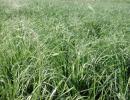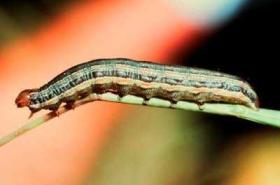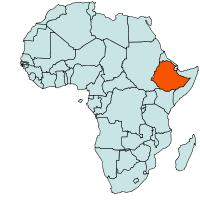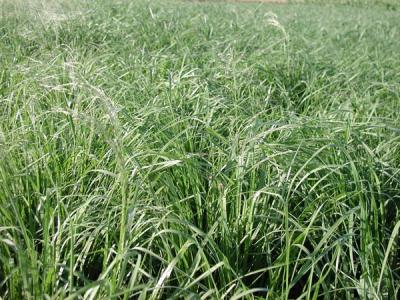
|
Teff
Scientific name:
Eragrostis tef
Order/Family:
Cyperales: Poaceae
Local names:
Teff (Amharic); Taffi (Oromo); Taff (Tigrigna)
Common names:
Lovegrass / Annual Bunch Grass (English) / Mil éthiopien (French).
Pests and Diseases:
African armyworm
Purple witchweed
|
The African armyworm (Spodoptera exempta)
It is an occasional but seriously destructive pest on teff in Ethiopia. It causes serious damage to young plants in years of armyworm outbreaks. The caterpillars feed on the leaves eating them down to the midrib. Outbreaks usually start during May in the southern provinces of Ethiopia. During the main growing season they move northwards.
- Monitor regularly field margins, low areas where plants have lodged, beneath plant debris around the base of plants, on the ground, and underneath the plant leaves. Check daily young crops if conditions are known to be favourable to the pest.
- Spray Bt or botanicals such as neem and pyrethrum extracts. Spray when caterpillars are small. Once caterpillars are mature (about 3 to 3.5 cm long) they may have cause serious damage and it may no longer be economical to treat the crop. For more information on (neem click here, for pyrethrum click here and for Bt click here)
- Conserve and encourage natural enemies. For more information on natural enemies click here
- Practise field sanitation. For more information on field sanitation click here

© University of Arkansas
 |
| Geographical Distribution of Teff in Africa |
The word tef is thought to originate from the Amharic word "teffa", which means lost (due to small size of the grain), or from the Arabic word "tahf" used by Semites in South Arabia.
Teff is an important food grain in Ethiopia and Eritrea, where it is used to make injera. Because of its small seeds (less than 1 mm diametre), a person can hold enough to sow an entire field in 1 hand. This property makes teff particularly suited to a semi-nomadic lifestyle.
Nutritive Value per 100 g of edible Portion
| Raw or Cooked Teff | Food Energy (Calories / %Daily Value*) |
Carbohydrates (g / %DV) |
Fat (g / %DV) |
Protein (g / %DV) |
Calcium (g / %DV) |
Phosphorus (mg / %DV) |
Iron (mg / %DV) |
Potassium (mg / %DV) |
Vitamin A (I.U) |
Vitamin C (I.U) |
Vitamin B 6 (I.U) |
Vitamin B 12 (I.U) |
Thiamine (mg / %DV) |
Riboflavin (mg / %DV) |
Ash (g / %DV) |
| Teff cooked | 101 / 5% | 19.9 / 7% | 0.7 / 1% | 3.9 / 8% | - | - | - | - | 2.0 IU / 0% | - | 0.1 / 5% | 0.0 / 0% | 0.2 / 12% | 0.0 / 2% | 0.7 |
| Teff uncooked | 367 / 18% | 73.1 / 24% | 2.4 / 4% | 13.3 / 27% | 180.0 / 18% | 429 / 43% | 7.6 / 42% | 427 / 12% | 9.0 IU / 0% | - | 0.5 / 24% | - | 0.4 / 26% | 0.3 / 16% | 2.4 |
Yields range from 300 to 3,000 kg per hectare, or even more. Although the national average in Ethiopia is 910 kg per hectare, yields of 2,000-2,200 kg per hectare are considered routinely attainable if good agronomic practices are carefully followed. Yields of 2,000 kg per hectare have been achieved on South African farms also, although storms have sometimes levelled the fields, resulting in large losses.
The grain is easy to store and will survive for many years in traditional storehouses without damage by insects. This makes it a valuable safeguard against famine. (Lost Crops of Africa: Vol. I: Grains (1996).
|
The African armyworm (Spodoptera exempta) It is an occasional but seriously destructive pest on teff in Ethiopia. It causes serious damage to young plants in years of armyworm outbreaks. The caterpillars feed on the leaves eating them down to the midrib. Outbreaks usually start during May in the southern provinces of Ethiopia. During the main growing season they move northwards. | 
African armyworm
African armyworm (Spodotera exempta). Mature caterpillars measure up to 4 cm. © University of Arkansas |
|
What to do:
|
- Germer, Renate (1985). Flora des pharaonischen Ägypten. Mainz: von Zabern. ISBN 3805306202.
- Insect pests of cereals in Ethiopia. www.ethiopia.ipm-info.org
- Lost Crops of Africa: Volume I: Grains (1996). NATIONAL RESEARCH COUNCIL Division on Policy and Global Affairs Development, Security, and Cooperation. Free online-version available: National Academies Press: www.nap.edu
- Nutrition Data www.nutritiondata.com.
- Wikipedia, the free encyclopedia www.en.wikipedia.org

 Back
Back
